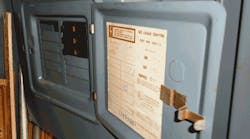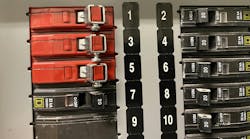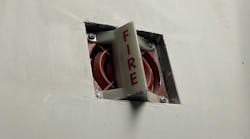How well do you know the Code? Think you can spot violations the original installer either ignored or couldn't identify? Here's your chance to moonlight as an electrical inspector and second-guess someone else's work from the safety of your living room or office. Joe, who has a knack for finding shoddy electrical work, did the dirty work and found this mess. Now it's your turn to identify the violation.
Find the Answer
EC&M reader Thomas Berton ran across this installation in a public school.
"While working in a school district on an energy-savings program, I came across this subpanel when a worker overloaded a circuit and it tripped offline," said Berton. "When searching for the tripped breaker, we found this beautifully installed panelboard. I can only imagine the pride the installer must have had as he skillfully cut the locker for his connections."
A Qualified Person is defined in Art. 100 of the NEC as, "One who has skills and knowledge related to the construction and operation of the electrical equipment and installations and has received safety training to recognize and avoid the hazards involved." This panelboard was obviously installed by an unqualified person who chose to pretend they were an electrician.
One of the most serious violations with this installation is the branch circuit appears to be improperly connected, which leads to lost equipment grounding conductor continuity. As noted in 250.118(14), surface metal raceways must be listed for grounding. A supporting informational note states, "For effective ground-fault current path, see 250.2 Definition."
The panelboard crammed into this small space also creates a violation of the working space requirements outlined in 110.26(A). "Working space for equipment operating at 600V, nominal, or less to ground and likely to require examination, adjustment, servicing, or maintenance while energized shall comply with the dimensions of 110.26(A)(1), (A)(2), and (A)(3) or as required or permitted elsewhere in this Code."






